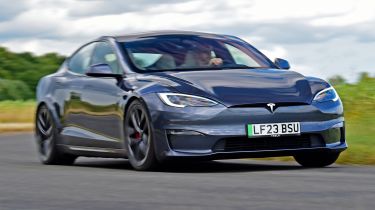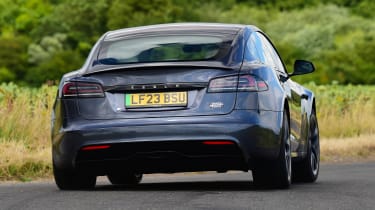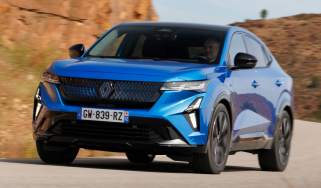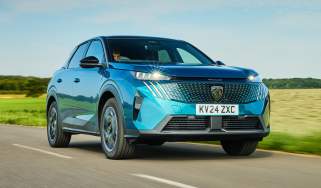Tesla Model S review - Electric motor, drive and performance
Performance is, erm, electrifying... with the Model S Plaid capable of humiliating everything and anyone that dare question its authority

It couldn’t be any simpler to drive a Model S: there’s no handbrake or starter button, because sensors detect when you're sitting in the car and turn it on. The updated Model S moves things on even closer towards full autonomy, because the gearshift stalk has been deleted altogether and the Model S software decides which direction you want to drive in, although you can override its decision via the touchscreen or a row of buttons on the centre console.
Driving on the left isn’t as big a problem as you might expect, because the plethora of radar sensors, cameras and safety systems let you know if there are any cars, bikes or pedestrians in your blind spot via the high-definition instrument cluster. Entering car parks and dealing with toll booths is a bit of a faff, though.
Give the throttle a gentle touch and the car responds instantly. All versions of the Model S have four-wheel drive and have plenty of traction. And when you're taking it easy, the Model S can cruise comfortably at motorway speeds. It’s not as quiet as a BMW i7 mind you, and you hear the whirr of the electric motor, as well as some roar from the tyres and wind, but it’s still a calmer environment than in a typical petrol or diesel car. The Tesla also comes loaded with kit that can help take the stress out of long journeys, and the firm’s Autopilot remains one of the smoothest and most advanced set-ups of its type.
Yet while the rapid acceleration will make you smile, any spirited driving will eat into your range. With a full charge, Tesla claims a range of close to 400 miles for its latest versions, but whatever your driving style the car’s energy flow data always keeps you fully informed, limiting range anxiety a little.
Used - available now

2016 Tesla
Model S
69,380 milesAutomaticElectric
Cash £27,800
2016 Tesla
Model S
55,600 milesAutomaticElectric
Cash £17,743
2016 Tesla
Model S
110,000 milesAutomaticElectric
Cash £17,500
2013 Tesla
Model S
6,800 milesAutomaticElectric
Cash £22,999We’ve yet to drive the standard dual-motor Model S in the UK, but we have tested the range-topping Model S Plaid on British roads. Our test car rode on the optional 21-inch Arachnid wheels, wrapped in super-grippy Michelin Pilot Sport 4S tyres. The sticky rubber gives the Model S gives the Model S terrific amounts of traction on both straight and winding roads, regardless of how much power you put down.
It’s poised when cornering, too, with very little body roll, though the steering lacks feel in all three of its settings, with Sport mode simply adding more weight. The much sportier Porsche Taycan is the more engaging and enjoyable car to drive, with the driving experience in the Model S more akin to a rollercoaster: you strap in and hold on. Unfortunately, the Plaid doesn’t get particularly supportive seats, so it feels as if you’re being thrown about quite a bit on twistier roads.
When you’re not attempting to break the sound barrier, the Model S still does the mundane stuff perfectly well. Switch the powertrain into Chill mode and the throttle response is dulled, plus there’s Comfort mode for the steering and suspension – which is how we expect most Model S owners will set up their cars, until they wish to flaunt its straight-line performance.
Every Model S features adaptive air suspension so it rides well and you can vary the ride height. A 'Low' setting is designed to offer the car even better high-speed aerodynamics to maximise the car's range, while the default ‘Medium’ height is meant to provide a balance between comfort and handling. The ‘High’ and ‘Very High’ are best reserved for speed bumps, steep driveways and other obstacles.
0-62mph acceleration and top speed
Tesla doesn’t release 0-62mph times for its cars. Instead, it states 0-60mph times, with the standard dual-motor Model S capable of hitting 60mph from a standstill in 3.1 seconds. That’s quick enough to show most supercars a clean pair of heels at the traffic lights, but hardly surprising when you consider it produces 661bhp. It has a top speed of 155mph.
If you fancy embarrassing some hypercar owners instead, then it’s the Plaid version you’ll be wanting. The tri-motor Model S pumps out 1,006bhp and a scarcely believable 1,420Nm of torque, all of which is available in an instant. The 0-60mph sprint takes just 1.99 seconds according to Tesla, although one slight caveat is that it excludes the initial rollout off the line, but the difference would be a few milliseconds at most. The Model S Plaid also gets a higher top speed of 200mph.
For a time, Tesla CEO Elon Musk said the firm would actually produce an even faster version of the Model S called the Plaid+, but it was cancelled.
Yet launching from a standstill isn’t when the Model S Plaid feels fastest; it’s even more addictive watching slower moving traffic disappear in your rear-view mirror as you hit the motorway. There’s no need to plan for overtakes either; you simply see a gap and seize it.










